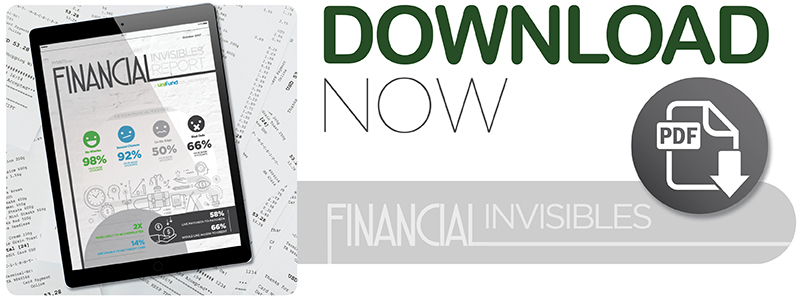The Need/Convenience Credit Card Paradox

Life happens, as the saying goes.
When life happens, though, all sorts of things also happen to financial visibility — including the ability to see one’s way toward tackling debt, the vagaries of day-to-day living (like food, clothing and shelter, among other basic necessities) and building a financial future.
In the “Financial Invisibles” report, a collaboration between PYMNTS and Unifund — a survey of more than 2,000 respondents on their financial situations and habits regarding credit use and credit access — the unavailability of basic financial services loomed large. In particular focus were those individuals who must navigate challenging credit-related and personal environments, where unforeseen events can be financially calamitous.
The headline numbers show credit card use may not be as prevalent as one might think. The report grouped respondents across four tiers, and participation in the financial system varied widely. Take the “No Worries” stratum, dominated by people with an average FICO score of 714, and where, as the study found, participation in the financial system remained robust.
The other end of the spectrum? That belongs to the “Shut Outs,” individuals who carry an average credit score of 525, have been marked by delinquencies and are unable to take part in the financial system, really, at all.
There are also the “On the Edge” individuals, with an average score of 589 — those who have not had any adverse credit events, and yet, by dint of struggling to make ends meet, are not able to be take part in the banking and credit system, though they may wish to do so.
Credit Invisibles: Just 34 Percent of “On the Edge” and “Shut Outs” Have Cards
From all of this fall the “credit invisibles,” those individuals who do not have access to credit cards and cannot or will not be able to obtain them.
In an interview with PYMNTS’ Karen Webster, Unifund CEO David Rosenberg discussed the fact that many financially invisible individuals do not have credit cards. It might come as no surprise that 65 percent of the “No Worries” designees have credit cards, as do 30 percent of those in the “On the Edge” group, but just 4 percent of the “Shut Outs” have them. Almost all of the remaining 96 percent within that “Shut Outs” category simply cannot gain access to traditional credit.
Without traditional plastic in hand, life becomes a little bit trickier to navigate. As Rosenberg noted, when booking rooms at a hotel or renting a car, or when performing any number of transactions — from buying items on Amazon to paying for gas at the pump — it can be standard practice to use a debit or credit card. That 16-digit number is a conduit to commerce, which begs a few questions about the invisibles.
“How are these people doing these activities?” Rosenberg asked. “Are they borrowing from a friend? Are they using prepaid cards?”
According to Webster and Rosenberg, insecurity may reign among the “voluntary” financial invisibles — those who willingly do not use traditional credit card products and who comprise 24 percent of the report’s sample. Perhaps these individuals do not share the confidence engine behind consumer spending, which, in an oft-repeated statistic, drives two-thirds of the U.S. economy. Worries over job security may linger as well.
Some firms have started to take notice of these individuals’ situations, said Webster, and they’re catering to the cash option for consumers, a nod to those who want to buy online but transact via hard currency. Walmart is a notable adherent of varied payment options, she added. The retail giant has a “pay with cash” feature, allowing shoppers to use a QR code, go to a physical pick-up location and pay for an online order using cash. Amazon recently began offered a similar service in tandem with 7-Eleven.
Utilization Is High Overall
As for credit use for those who do have cards, average utilization spans 30 percent to 40 percent, said Rosenberg. He added that “for the ‘On the Edge’ guys, utilization is high — and higher than the prime [‘No Worries’] people.”
Rosenberg also noted that the “On the Edge” cohort may be a relatively smaller segment of the population, “but there is larger [credit use] penetration within that group.”
FICO, for its part, has said utilization of less than 30 percent is optimal. In their discussion, Webster and Rosenberg dissected that super-prime designees use 4 percent of any one available credit line and no more than 10 percent of all lines. Conversely, subprime credit utilization is at a staggering 94 percent.
Paycheck to Paycheck: A Way of Life with Credit as a Bridge
The ways individuals use credit diverge. Against a backdrop in which 68 percent of all respondents said they live paycheck to paycheck, cardholders either revolve their balances or pay them off monthly. Prime users implement credit to take advantage of points for rewards, Rosenberg explained, and those who lean on revolving balances do so to pay bills. Thus, credit becomes a vehicle that is either “needs-based or convenience-based.”
In the case of the former scenario, in which credit is heavily utilized as a financial tool, the people who are busy trying to make ends meet are “people who are always in a recession, and so there is always this sense of ‘When is the next shoe going to drop?’” Rosenberg explained. “They may have two jobs, trying to make ends meet. These are not people who are living close to or below the poverty line but who are making $50,000 to $60,000 annually.”
In other words, the struggles are real — and more commonplace than one might think.
About the Report
The PYMNTS Financial Invisibles Report, a Unifund collaboration, focuses on how individuals handle bill payments and use credit products, as well as the impact of traumatic events on an individual’s financial stability.
To compile the Report, PYMNTS surveyed more than 2,000 Americans and asked them about their financial habits and circumstances. Overall, our sample demographically mirrors the U.S. population with one important exception: We sought relatively low-income Americans to help deepen our insights into the use of credit by those who are financially challenged.

